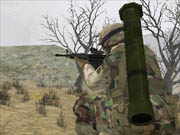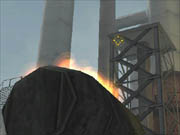The Ghosts are back. After first appearing in last year's tactical shooter Ghost Recon, this fictional team of elite US soldiers returns in Desert Siege. This expansion pack takes you through eight single-player missions in the sands of Africa and adds welcome new multiplayer options to the original game. It also features some subtle but important improvements to the original gameplay that make Ghost Recon a more polished and enjoyable game as a whole.

The setting of Ghost Recon was pretty typical: You battled your way through former Soviet states threatened by Russian ultranationalists. Desert Siege offers up a more unusual setting. This time, you'll help Eritrea stave off an invasion led by an Ethiopian dictator. At first, this may sound pretty obscure, but it's actually quite topical. In real life, Eritrea won its independence from Ethiopia only about 10 years ago after decades of war. Fighting flared up again between the two nations just a few years ago. Plus, images of US troops fighting in sandy wastes or in Africa itself have become familiar through US operations in the Persian Gulf, Somalia (Ethiopia's neighbor), and Afghanistan.
In the single-player missions, you'll get theoretically varied mission objectives, though they almost all boil down to one thing: Very gingerly wend your way through the maps, picking off enemies from afar. Expect relatively little in the way of extended firefights or close-quarters battles, but expect loads of sneaking and sniping. The missions aren't especially original, though they vary enough to be entertaining overall.
More than any particular combat encounters, what stands out about the missions are the environments themselves. The towering refinery of the second mission is particularly impressive, and a railroad yard provides the opportunity for some intense sneaking in a later mission. Some of the missions take place at night, but the daylight ones have the added benefit of showcasing Ghost Recon's graphics engine. The blazing sun lets you appreciate the visual details far more readily than the shady areas found in many of the original Ghost Recon missions did. The textures and animations (other than the slow-motion enemy deaths and dated-looking explosions) generally look really impressive.
The core single-player gameplay of Ghost Recon remains essentially unchanged in Desert Siege. Before each mission, you get a briefing describing core and bonus mission goals. You also get a rudimentary map of the mission area. After studying the situation, you fill up to three fireteams with soldiers of your choice. Each team can include up to three men, though you can enter a mission with only six men total. You can assume the role of any of these soldiers at any time during a mission.

Each soldier has a specialty, like rifleman or sniper, that determines what weapon kits you can select for him or her before each mission. Since each kit contains only two items (like a machine gun and extra ammo or an assault rifle and binoculars), you need to choose carefully based on the mission requirements and terrain. It does seem odd, though, that a soldier can't carry grenades, binoculars, and a rifle all at once. Also, you can't pick up dropped weapons or gear, so you'll need to restart the mission if you lose a soldier carrying a rocket launcher needed to take out a SAM site, for example. A bug that sometimes prevents you from reloading or switching weapons can cause the same end result.
By completing bonus mission goals, you'll gain access to specialist characters with otherwise unavailable weapons. Desert Siege adds five specialists with new weapons like the Russian PKM machine gun. For multiplayer games, you'll find even more new weapons. You'll get the M60 machine gun, familiar to anyone who's seen a Vietnam War documentary, and the FN-FAL Para Variant assault rifle designed for airborne troops. Quite a few Russian weapons are added, like the Groza assault rifle/40mm grenade launcher combo and the AN-94, scheduled to replace the aging AK-74. You'll get two new sniper rifles: the 7.62mm H&K PSG-1 and the Barrett M98, which fires a .338 magnum round. While these weapons don't substantially change gameplay, it's always nice to have a wide selection of firearms. You still can't see your gun barrel or sights in the first-person view, only a targeting reticle. Also, environments remain essentially indestructible.
As you play the single-player missions, you'll learn that some of the problems that hurt Ghost Recon remain in Desert Siege. The troop command interface and map are still rather clumsy, particularly in the heat of battle. You'll often end up jumping between teams and moving them manually to keep them alive. This decreases the immersion, makes coordinated tactics difficult, and defeats the point of being able to give orders to others in the first place. If you're not jumping between teams, you'll just play as a sniper and take out most of the enemies yourself, calling up the rest of your men when the coast is relatively clear to provide a little suppressing fire or take out a tank. Most of the missions encourage this sort of behavior, thanks to their wide-open spaces.

Happily, your troops are brighter than in the past. Ghost Recon was hurt by its weak AI, but Desert Siege offers some improvements in that area, some of which first appeared in a recent Ghost Recon patch. These tweaks make your fellow troops act a little more like assets than liabilities. That said, they still don't always behave as wisely or realistically as you'd like, and certainly not with the skill you'd expect of elite soldiers. They'll still get stuck on terrain (particularly buildings), requiring you to move them manually, or they'll kill each other with friendly fire when it could have been avoided easily.The enemy troops now behave somewhat more realistically as well: They're not all crack shots anymore, though they do tend to mill around casually even as shots ring out in the area. So when you beat a mission, you'll sometimes feel like you've beaten a level designer, not a wily, tactically proficient enemy force.
While the single-player game mechanics remain essentially unchanged, multiplayer gets some significant changes and improvements. A new leaderboard makes tracking scores easier, for example. There are also four interesting new multiplayer (or single-player firefight/recon) maps, set in varied locales like the canyons of Colorado or a stronghold near Ft. Bragg, North Carolina. You'll also get to play various multiplayer modes on the eight maps from the single-player missions.
Perhaps the most important new multiplayer offerings in Desert Siege are the new domination and siege modes. Many of the original multiplayer modes in Ghost Recon had far more in common with traditional run-and-gun shooters than realistic military operations. The new modes more readily call to mind believable combat objectives. Sadly, just as in the single-player game, you'll still find an undue and unrealistic overemphasis on distant sniping over midrange suppression by machine guns or close-quarters fighting with submachine guns and grenades. Ubi Soft's buggy and awkward matchmaking service still desperately needs an overhaul, too, though you're free to use other services.
In the new domination mode, teams try to reach and hold key zones for as long as possible. To hold a zone and earn points, at least one of your teammates needs to be in it while preventing the enemy from entering. Team coordination is a must if you want to cover various avenues of approach effectively. In a welcome touch, kills don't earn you any points. They're just a means to a military end: controlling territory. Glory hounds need not apply.

Siege mode puts the smallest of multiple teams in a base that it has to defend from one or more larger assaulting teams. The attackers gain control of the base by infiltrating its core and keeping at least one of their men alive there for five seconds or more. Unfortunately, if the server is set for infinite respawns, it becomes all too easy for defenders to camp the respawn points on certain maps, ruining the match. Of course, immature players will find ways to abuse any game.
Whatever its weaknesses, Desert Siege has plenty of strengths and offers a real bang for the buck, given its $20 retail price: Hard-core Ghost Recon players will be able to complete the single-player missions in an afternoon, but then there are all the new multiplayer possibilities. Meanwhile, casual Ghost Recon players will likely find in Desert Siege a good, solid military shooter experience that plays better than the original.